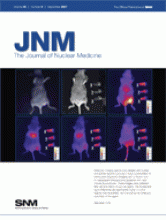REPLY: We thank Aide and Bardet for their comments on our article and would like to take this opportunity to briefly elaborate on the complex relationship between calcitonin, prognosis, and PET positivity.
In general, the probability for detecting sites of recurrent or metastatic disease on 18F-FDG PET increases with tumor marker levels. This has been shown, for instance, in prostate cancer (prostate-specific antigen) (1), ovarian cancer (CA125) (2), colorectal cancer (carcinoembryonic antigen) (3), and breast cancer (CA15-3) (4). It is also clear that low tumor marker levels, in general, indicate low volume (“subclinical”) disease recurrence, and oftentimes the findings of all imaging tests (structural or functional) are initially negative in these individuals. In fact, even with markedly elevated tumor marker levels, all imaging studies may show negative findings in some patients with, for instance, prostate cancer (prostate-specific antigen) or medullary thyroid carcinoma (MTC) (calcitonin). In patients with MTC who have a markedly elevated calcitonin level and negative imaging findings, it is not unusual to detect subcapsular liver metastasis on laparoscopy.
Our study (5) established that the sensitivity for disease detection by 18F-FDG PET is higher in patients with calcitonin levels of more than 1,000 pg/mL. Aide and Bardet correctly point out that the use of different laboratory tests for calcitonin makes it difficult to apply this 1,000 pg/mL value universally. They suggest that using calcitonin doubling time, which also yields prognostic information, would circumvent this problem (a 100% increase is a 100% increase, regardless of the base point, units, or specific test kit, as long as the same test is applied all the time). Indeed, for many cancers evidence is now increasing that tumor marker doubling time is an important prognostic factor (4,6,7), and this is also true for MTC: In the study by Bardet et al. (8) in 65 patients with MTC, a calcitonin doubling time of less than 6 mo indicated a particularly poor prognosis, with 5- and 10-y survival rates of 25% and 8%, respectively. Similarly, in a retrospective cohort study of 120 patients with MTC, de Groot et al. (9) reported a worse clinical outcome among individuals with a calcitonin doubling time of less than 1 y. It is certainly plausible that a shorter calcitonin doubling time correlates with tumor progression and presumably also with lesion growth and metabolism. If the latter were true, one would expect a higher rate of PET-positive cases in individuals with shorter calcitonin doubling times.
We were able to calculate the calcitonin doubling time in 22 of the 38 PET scans in our study (12 true-positive, 9 false-negative, and 1 false-positive). Although there was a trend toward a shorter doubling time in PET-positive cases, the difference was not significant (6.6 vs. 12.1 mo), as may be explained by the relatively small patient sample and the considerable overlap in data points. When applying the suggested cutoff of 6 mo, we arrive at the following results: Among those with a doubling time of less than 6 mo, 4 scans were true-positive and 4 were false-negative. Among scans with a doubling time of more than 6 mo, 8 were true-positive and 5 were false-negative (1 finding was false-positive). For comparison, we also applied a cutoff of 1 y: Among patients with a doubling time of less than 1 y, 9 scans were positive and 4 were negative; among those with a doubling time of more than 12 mo, 3 scans were positive and 4 were negative. Thus, the cutoff of 1 y seemed to provide somewhat better sensitivity, but overall, the number of data points is simply too small for meaningful conclusions in this regard.
Persistent or recurrent hypercalcitonemia after thyroidectomy is not necessarily associated with poor long-term outcome, particularly in the absence of clinical signs of residual, recurrent, or metastatic disease (9,10). In a retrospective study of 120 patients with MTC from The Netherlands (9), 30% of deaths in the cases with persistent biochemical disease were not due to MTC, and some patients with persistent MTC even had a standardized survival time better than the average Dutch population of similar age. This finding reflects the clinical experience that some patients with biochemically persistent MTC will have an indolent clinical course. In that study, 24% of patients with a persistently elevated calcitonin level remained clinically disease-free even after long-term follow-up.
Finally, 18F-FDG may not be an optimal radiotracer for MTC. For instance, it is conceivable that imaging with 18F-fluorodihydroxyphenylalanine will be more sensitive for detecting sites of disease at lower calcitonin levels and may also associate better with the prognostically important parameter calcitonin doubling time.
Footnotes
-
COPYRIGHT © 2007 by the Society of Nuclear Medicine, Inc.







